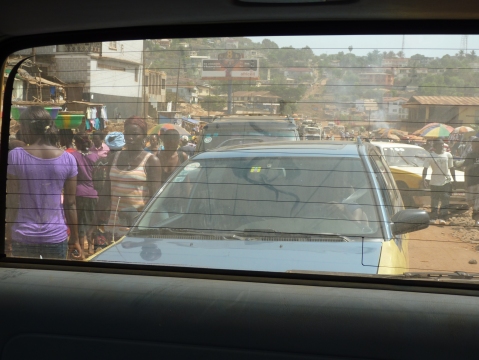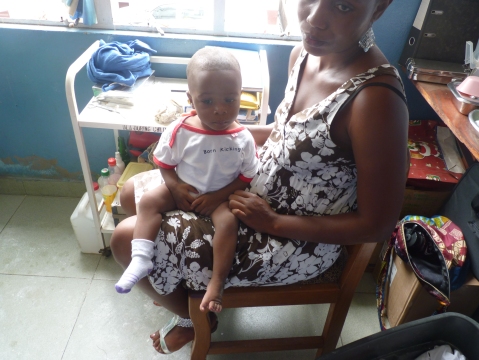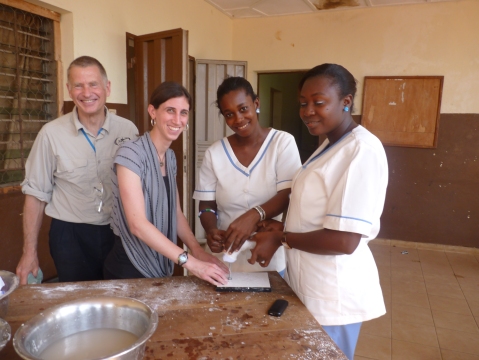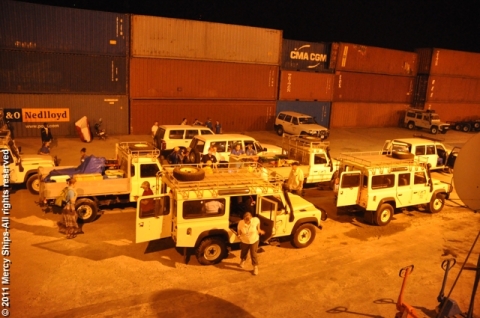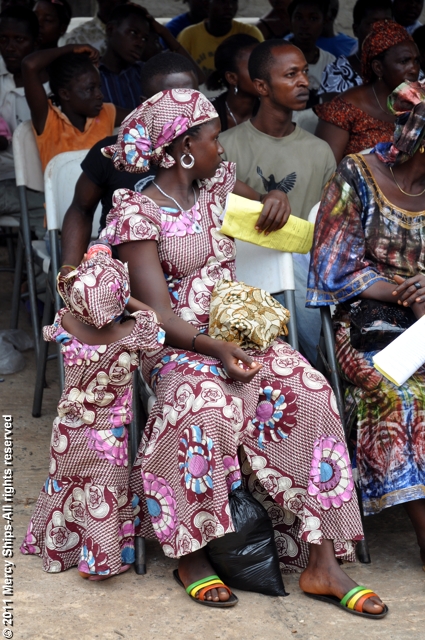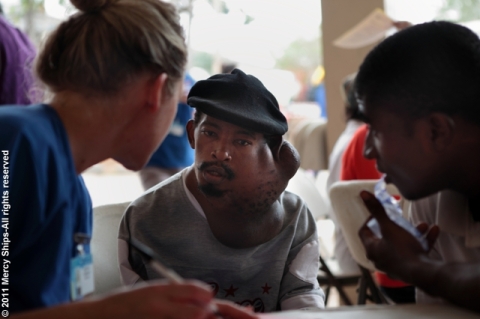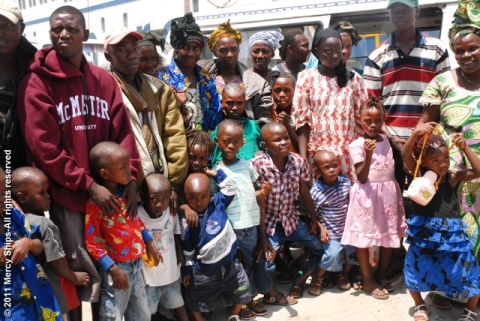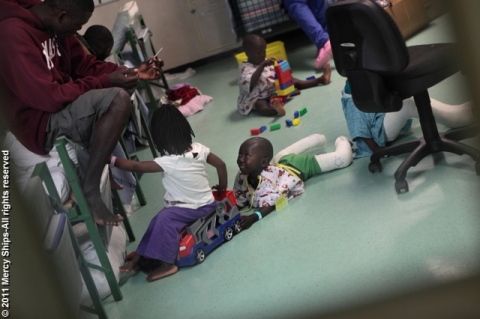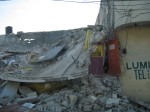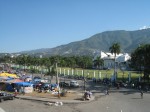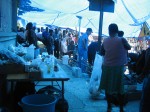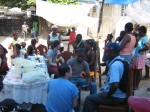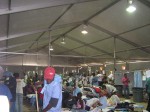Short stories
April 25, 2011
I have realized it’s been a couple weeks since my last post, so I thought I would bring everyone up to date with a few pictures and stories to go with them. These last two weeks have flown by, and I’m trying to remember everything that went on during that time… The post op clinic has become my main focus, so many of my days are filled with cast saws and crying children (but thankfully happy parents!), along with the cute babies that we’re casting for club feet. We’re about to hit the 6 week post-op time for a number of the kiddos, which means I should hopefully get to take some casts off for good, and see some straight legs. I’m looking forward to that. I’ve also been able to go spend some more time with the Brockelman’s, which was great, go to the beach, and celebrate Easter on the ship, which was very special. I’ll start with a couple of my patients..

This is Abu (he's 8 months old). He was born with hyperextended knees that didn't bend. His mom was told that he must be cursed, and she shouldn't take care of him. Now with a fairly simple surgery he has legs that bend and work well! It just breaks my heart to hear stories like this, but unfortunately we hear them all the time.

This is Fanie- he came from way up north, where there is very little access to healthcare. He has one of the most precious smiles ever- I don't think I've ever said hello to him without a big smile breaking out on his face. The bends in his legs are from a disease called osteogenesis imperfecta, which means he has very soft, weak bones that break and bend easily. I wasn't sure if we would be able to help him much, but the orthopedic surgeons were able to use a few creative techniques, and have straightened out his legs immensely. I wish I was going to be here when his casts come off in a month or so!
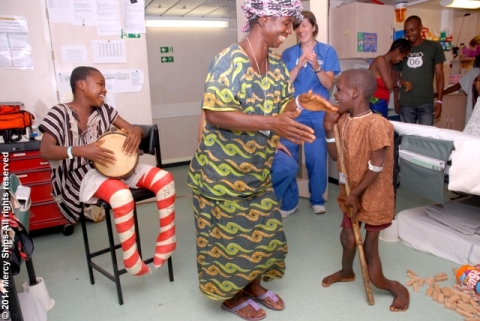
It's not uncommon for me to walk down the halls of the hospital and hear the drums and singing going on in the ward. Here our patient Tamba is playing the drums, and Fanie and a patient's mom are singing along. Tamba is an older kid with club feet. He's been walking on them, and they were essentially backwards when he came a few weeks ago. We are doing weekly casting on his feet, just like in the little babies, hoping to stretch them out before he gets surgery next week. He can be found out in the hall wheelchair racing with 2 other boys his age who have casts on both legs too. It's a sight to see for sure!

This is Namina- she is actually a maxillofacial patient, but I've gotten to see her as she comes in to the post op clinic to get dressing changes. She had a disease called Noma when she was a small child. Noma is an infection of the skin that causes gangrene and tissue destruction of the face. It is only found in areas of severe malnutrition, such as West Africa. The last time it was noted in the developed world was during World War II in the concentration camps. It usually affects small malnourished children, and about 90% of the patients who get it die. The 10% who survive are left with a hole in their face, where the noma destroyed the tissue. Such was the case with Namina. She had tissue destruction around her eye, and our very experienced Max-fax surgeon, who has been on the ship for over 20 years, was able to do reconstructive surgery to help her have a normal face again. She's a fiery litttle thing, and has slowly been smiling more as her wounds have healed.

This is Sally, or queen Sally as we call her. Every day, when I as her "Ow de body?" (which means how are you?) she responds with "tell God tenkie", which means tell God thank you. I love her attitude, and wonder how much more full of joy my life would be if I approached it with thankfulness all the time.

This is Salu. I see him twice a week for dressing changes to his leg. He had a bad cut on his leg 2 years ago that was untreated, and developed a severe bone infection in his femur called osteomyelitis. Osteomyelitis is very difficult to treat even in the States, and for the most part we can't treat it on the ship, because it takes a lot of time and resources that we just don't have. But Salu had a piece of dead bone in his leg that we think was causing the continued infection, so he was taken to surgery a few weeks ago to remove the dead bone. Now I check and redress his draining wounds twice a week. They are healing slowly, and I'm praying that the infection will improve with time, because there is not much else we can do for him right now except to watch, wait, and pray.

This weekend we went to an orphanage that our friend Chuck helps out with. The lady who runs the orphanage has been taking kids for 25 years, even during the war. This little girl that I'm holding was found in the trash dump as a newborn, and the orphanage has cared for her since. Right now the orphanage has 64 kids. Even though they have limited resources, and live basically by faith to take care of these kids, you can tell that the children are well loved, and the caretakers do their very best with what they have. It was humbling to meet a lady like the one who runs this orphanage, who has devoted much of her life to caring for and loving children who are not even her own.

Last weekend I went to Burah beach. It was beautiful, and a great time of relaxing. We even got fresh seafood that the locals went out and caught- it was yummy! And my friend Liz and I decided to swim out to the island that you see in the distance, which was of course a lot of fun.
The ship had a meaningful Easter service and brunch on Sunday that everyone dressed up for. It was great to celebrate the resurrection of Christ with the people who you are serving alongside on a daily basis. It was a good reminder to me that we are here because the love of Christ, and the hope we have in Him.
This is love: not that we loved God, but that he loved us and sent his Son as an atoning sacrifice for our sins. Dear friends, since God so loved us, we also ought to love one another. No one has ever seen God; but if we love one another, God lives in us and his love is made complete in us.
1 John 4:10-12
Weekend away
April 9, 2011
I’m on call this weekend, which means a lot of hanging around on the ship, while most people are out and about town. So I thought I could get a little blogging done. I wanted to mention first, to pray for water! Water for the country, and for the ship. It’s the end of dry season here in Sierra Leone, and the water supply is becoming scarce for everyone. The missionaries that I visited last week have had to have their water delivered because the wells are running dry. Here on the ship, we are having some major issues as well, to the point that the general water supply has been turned off on the ship right now until we can get more fresh water. It’s crazy that we’re sitting on a body of water, but don’t have any way of getting fresh water. The captain is beginning to think we may have a leak somewhere that is causing us to use much more water than usual. This is an issue that needs to be fixed, and fixed soon, so we would appreciate your prayers.
On a different note, I wanted to tell you a little about my weekend off the ship last weekend. Before I left, I was given the contact information of the Brockelman’s, some missionaries just outside of Freetown that my boyfriend’s parents know. I was able to get in touch with them, and they graciously invited me and Jana to spend the weekend with them in Grafton- the town that they live in. It was a relaxing weekend away. I had a great time visiting with some “real” missionaries, and seeing a little more of the country, and what kind of work they are doing here. Becky and her driver picked us up Saturday morning and took us to River Number 2, a beach on the east side of town. We had lunch there, and even did a little shopping at the craft market. Sierra Leone has some beautiful beaches, and it was nice to spend the morning there.
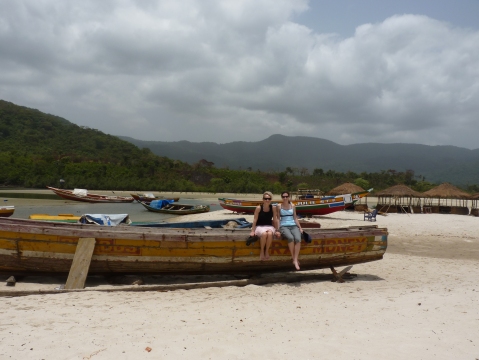 After lunch and walking on the very windy beach, Becky suggested we go explore a waterfall that she had read about. So we drove on the “mountain road” to the turnoff for this village where the falls were supposed to be located. A local met us at the road to the village, and became our tour guide to the falls. It was about a 20 minute walk, and included lots of cute kids who would hold your hand for about 50 feet and then run back to their house. The waterfall was pretty small since it’s the end of dry season, but it was still nice to see.
After lunch and walking on the very windy beach, Becky suggested we go explore a waterfall that she had read about. So we drove on the “mountain road” to the turnoff for this village where the falls were supposed to be located. A local met us at the road to the village, and became our tour guide to the falls. It was about a 20 minute walk, and included lots of cute kids who would hold your hand for about 50 feet and then run back to their house. The waterfall was pretty small since it’s the end of dry season, but it was still nice to see. After the falls, we drove to Grafton, and got to hear a little history of the area. After the war the government decided to relocate a number of different refugees to the city, and many are still there now. There is an area for war widows, amputees, and polio victims. Right after the war there was a large amount of help for these people through different non-governmental organizations (NGO’s as they are called in developing countries), which basically means charity organizations. But more recently the NGO’s have moved out of the region, and now there are people left behind who have very little skills and no resources. The Brockelman’s and another missionary we met named Chuck are working in the community and a neighboring community to teach skills development. They are also involved in a number of other projects that are doing great deal for the people of Sierra Leone. You can read about the Brockelman’s work at alifeonmission.blogspot.com and Chuck’s work at http://www.chuckinwestafrica.blogspot.com
After the falls, we drove to Grafton, and got to hear a little history of the area. After the war the government decided to relocate a number of different refugees to the city, and many are still there now. There is an area for war widows, amputees, and polio victims. Right after the war there was a large amount of help for these people through different non-governmental organizations (NGO’s as they are called in developing countries), which basically means charity organizations. But more recently the NGO’s have moved out of the region, and now there are people left behind who have very little skills and no resources. The Brockelman’s and another missionary we met named Chuck are working in the community and a neighboring community to teach skills development. They are also involved in a number of other projects that are doing great deal for the people of Sierra Leone. You can read about the Brockelman’s work at alifeonmission.blogspot.com and Chuck’s work at http://www.chuckinwestafrica.blogspot.com
We spent the rest of the evening walking around town, and then eating a good meal prepared by Becky. Thank you Becky! The next day we saw the community center that they are working out of, and then headed back to the ship after a good lunch in town. It was very refreshing to spend a night off of the ship, and to get a better feel for the country. It is a beautiful country with warm, friendly people, and I can see why people like the Brockelman’s and Chuck have decided to come here to live and serve. Here are a couple other pics from the weekend.
Ponseti
April 9, 2011
The last time I was in Africa, I wrote about a casting technique called Ponseti casting that I had learned for treating children with clubfeet. Since that time, the main orthopedic surgeon on the ship, Dr. Frank, has worked to build a teaching program to teach medical professionals in the country about the Ponseti technique. It requires a series of castings where you manipulate the foot every week, with the end goal of a functional foot. The technique has finally caught on in the United States as the main way of treating clubfoot, and it is a great way to treat it in developing countries, because it is relatively low cost, and does not require major surgery.
This year I’ve been able to go to a local hospital with Dr. Frank and Anna, the physiotherapist (PT), to help with a clubfoot clinic. Anna will continue teaching there all year, with the hope that the medical staff that we are teaching will be able to be proficient in the method by the end of the year. It is quite an involved process, with the need for follow up and bracing for the children until they are about 5 years old, but is definitely worth it if it can be done. We have had more and more patients come to each clinic day, and now we’re struggling to get enough teaching in and still be efficient enough to finish the clinic in time to get back to our patients on the ship. I love getting to see the kids every week, and see the progress we are making. Here are a few pictures of the “clinic”, which is actually just a little casting room with too many people and patients in one area.
We were also invited to the National Rehabilitation Center this week to give a short seminar on Ponseti. Thankfully we had a director from Cure Clubfoot International visiting us this week, and she was able to help us out with lecture resources, etc. The seminar went well, although the clinic is not quite ready to be up and runnning at this point. Hopefully this was a good start to let them know what is possible, and some more permanent organizations will be able to come in and build on the knowledge they now know.
Screening Day 2011
April 5, 2011
Well, I’ve been meaning to write this update for a while, but I just now got some pictures from communications from screening day, so now I have no excuse for writing. We had a great and successfuly screening day last Saturday- thank you all for your prayers! We had security teams out all night long to help keep the crowd in a line, and to turn away people early who we knew we wouldn’t be able to help. Then the rest of us left the ship between 5 and 6am to get to the site, and get ready for the day. When we got there, there were about a thousand people in line ready to be seen. A group of about 15 of us from the hospital went outside the gates and saw the people for an initial screening. Everything went very well, and we spent about 2 hours seeing patient after patient and getting through the initial line. I was the only orthopedic person outside the gate, so I mysteriously seemed to see all of the people with orthopedic problems. There were many people who were good surgical candidates, and I was happy to say yes to probably 30-40 percent of the people I saw.
It proved to be very difficult to say no to so many though, knowing that we really were their last chance. There is nothing easy about having a life altering disease anywhere in the world, but the scope of suffering that people here go through is almost too much for me to grasp. It makes me understand better the passage in Romans 8:22-23 that talks about how we, as well as all of creation, groan under the load of this broken and painful world, and sometimes we can only hope for something better. It’s my hope that our work here in Sierra Leone can bring hope and physical and spiritual healing to as many as possible, and in doing so, bring a little taste of the kindgom of God to earth as it already is in heaven.
So, I spent the next few hours continuing to screen those that came to the line, and then once things slowed down, I went inside the gates to help with the process of registering the patients, and having them seen by a doctor. Overall it was a very successful day, and one that I won’t soon forget. Here are some pictures, and Iwill also have a link up soon on the side to a few more pictures.
Vehicles leaving early in the morning
The line of patients outside the gates
Momma with her cleft palate baby
My friend Liz with a cute little patient
The waiting area once inside.
A possible maxillofacial patient getting registered.
Oportu!
March 25, 2011
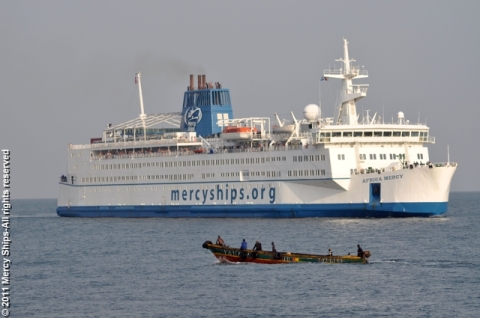 After about 30 hours of traveling, I finally arrived in Freetown, Sierra Leone late last Friday night. It felt good to step off the plane to the warm, humid air of the Sierra Leone, and know that I finally made it back to Africa! I arrived without any difficulty other than a bag missing, which was delivered to me 6 days after I got here- just a little reminder that I am officially on Africa time.
After about 30 hours of traveling, I finally arrived in Freetown, Sierra Leone late last Friday night. It felt good to step off the plane to the warm, humid air of the Sierra Leone, and know that I finally made it back to Africa! I arrived without any difficulty other than a bag missing, which was delivered to me 6 days after I got here- just a little reminder that I am officially on Africa time.
I spent last Saturday recovering from the traveling, and then Sunday decided to venture out on a walk/hike with a couple of the orthopedic surgeons, and a local man who wanted to show us around the city. As we began to walk the crowded, rocky streets, alleys, and paths, I noticed the kids calling “oportu!” over and over again. I quickly learned that this word, which sounds sort of like they are calling “a photo!” is not a bunch of kids wanting a picture (although that is definitely welcomed) but is instead the Temne word for white person. That seems to be the first word that becomes noticeable to me in any country I’ve gone to, so I guess Sierra Leone is no exception to that rule.
After a weekend of relaxing and catching up with friends, I found myself walking down the halls Monday morning ready to get to work. I passed kids and adults alike with bowed legs, backwards feet, facial tumors, etc, and immediately remembered the reason that I love this place so much. I actually get to play a tangible role in changing these people’s lives forever- crazy! Most of our patients are in some ways outcasts of society, and it is a priviledge to be a part of a group that seeks to love these people the way Christ loves us, and be able to show that love in a very practical way. Here are some pictures of a few of my patients- there are all so cute.

The boy on the right just had his legs straightened. He should be able to walk normally in about 8 weeks.
It’s been a busier week than usual for the ship, because not only are we on our second week of surgery, but the administration is planning a second screening day to continue the one that they had two weeks ago. The ship came in to Freetown at the beginning of March, and planned for a day of screening, where about 5,000 people were expected to show up who might benefit from the types of surgeries that we do (mostly visible deformities such as facial tumors or club feet, that interfere with living a normal life). The screening day started out normally, but as the time passed, the crowd grew and became restless to the point that the everyone rushed the gates and started crushing one another to get in. When it was all over, one African man had been trampled to death, and 11 more were injured and had to be taken to the hospital. The screening was canceled and the crew came immediately back to the ship. I was not here when screening happened, but I know that it was a sobering time for the crew, and made everyone realize the desperation that must be felt by the people who live in Sierra Leone. There was a civil war here about 10 years ago, and because of that, Sierra Leone is considered to be the second poorest nation in the world. With that poverty comes a lack of basic resources such as health care, so it is understandable that things can become chaotic and desperate when someone knows that we may be their only answer for healing. It’s a problem that I can’t even imagine for myself. And while we don’t want what happened to be repeated, we are still in Sierra Leone to serve and bring hope and healing to those who otherwise would not recieve it. Therefore a second screening has been scheduled tomorrow to see patients and schedule surgeries.
I found out that I’ll be on the pre-screening team in the morning, which means I’ll be out in front of the gate, telling people yes, you have a problem we can treat, or no, we cannot help. We’re expecting another 5,000 people to show up, and will probably have to tell 90% of them no. It’s not going to be an easy day, but I’m glad to be able to see people, and help where I can. It’s interesting (well, God seems to have a funny way of working things out like this) that I have been working in the triage portion of my ER at home, and have gotten quite used to seeing and categorizing 50-100 people a day. So I feel like in some ways I’ve been prepared for this task, only this time instead of 50, it could be a couple hundred. And instead of helping those that could go down the road and get help at another hospital, I’ll be telling many people who literally have nowhere else to turn, that there is nothing I can do for them. Please pray that we will all have the energy and the grace to help as many as we can, and to be loving in our response to those that we can’t help. And you can also pray for the safety of the crew, and the people standing in line. There are many more safety precautions being taken this time around, so don’t worry mom, we will be okay!
Haiti
February 13, 2010
On January 26th, 2009 I boarded a plane to Africa, not knowing that exactly one year later to the day, I would be headed to Haiti. It was almost surreal to be at the airport facing a new set of unknowns, and yet having this past year of experiences to reassure me that even in the unknown, the Lord knows.
The adventure began almost immediately when I met up with the rest of our team, and we had a ratio of about 1 person to 5 oversized bags each. We all breathed a sigh of relief as 3 amazing American Airlines employees came to our aid to help us repack and check all of our bags at no charge. Everyone seemed to want to do whatever they could to help Haiti, and it was a refreshing start of the trip. We then flew on a succession of planes and that ended up in to Santo Domingo, Dominican Republic at about 11pm. We were about 15 bags short (seems like a lot, but not too shabby considering the amount we checked), but thankfully we found all our team members, including my friend Jana from the ship, and headed to the Youth With a Mission (YWAM) base to get a couple hours sleep before leaving for Haiti at 4am.
The next day was spent driving from the Dominican Republic to Port-au-Prince, Haiti. We were all eager to get there and start working, but by the time we arrived at the orphanage where we were staying, it was too late for all of us to get out to the city. So a group of about 6 headed out to check things out, and I stayed behind with the rest of the team to set up camp. Over the next week and a half I was continually grateful to have this orphanage to come back to in the evenings. It was situated on the outskirts of the city, and was not damaged too badly in the earthquake, and was a great place to come to after working in disaster areas during the day.
That afternoon I had time to sit and think and pray before beginning the relief work. As I sat there, my thoughts were continually interrupted by constant taking off and landing of military airplanes at the Port-au-Prince airport, which was very close by. It was a strange feeling to be sitting in an untouched area, and yet hear the reminders of the relief that was going on all around me. What I found out shortly thereafter was that I was only about 100 meters from some of the youngest victims of the earthquake. The orphanage where we stayed had opened their chapel area to house and nurse post-operative children from the Navy hospital ship that was docked in the port. I walked in that evening to see over 20 kids who had been crushed, trapped, or severely injured in the earthquake, who were now smiling and greeting me in the warm way that seems to embody the Haitian people.
Many of those kids had injuries that will heal by the time the casts come off, but there are some who don’t have that luxury, and those kids are the ones that I think I’ll always remember. Christelle was one in particular. She’s an outgoing teenager who immediately starts trying to teach you Creole when you walk in. She lost a leg in the earthquake, but also lost both of her parents. Most of the kids had at least one relative with them, but she had no one. I don’t know what will happen to her, but my heart breaks for her and all the other kids who have lost so much in this tragedy.
After spending some time with the kids, we headed off for an early bedtime. The next morning a few of our team members, including Jana who is a physical therapist, headed off to a field hospital where they could use their specialty best. The rest of us drove across town, past the rubble, tent cities, and long lines of Haitians at the Western Unions, to a clinic that the prior team had established across from the President’s palace.
The clinic was set up at the national police headquarters a couple of days after the earthquake by volunteers from YWAM’s Dominican Republic base. The first weeks they were overrun with patients, but by the time we arrived, things were a little more under control. We jumped right in seeing patients, many of whom had wounds that needed daily dressings from the earthquake. The clinic even had an area used as a minor operating room. The table was actually the national police chief’s desk. I spent the next few days seeing patients all day, and we usually saw about 600 patients in any given day. The first few days it was mostly earthquake related problems, and a large amount of post traumatic stress symptoms.
The amount of people affected by the earthquake was just overwhelming. Every person I talked to had lost their homes, and were living on the street with no clean water, no privacy, and no idea what might be next. The look on many of their faces was one of shock and just a numb sadness. They would come in with a headache, but once you asked, they would tell you that they lost a sister or brother, or mother, not to mention countless friends during the earthquake. Many people just needed someone to share with, and someone to pray with them, and I’m glad I could be there for that.
It became apparent after a few days though, that the minor acute health issues associated with the earthquake were improving, as we noticed a decrease in the amount of wound care, and an increase in the amount of primary care issues. Our clinic was not set up for long term primary care, so we decided to take some mobile clinics out in to the harder hit areas and care for people there as well. Unfortunately we found that mobile clinics could be very hit and miss as far as their effectiveness. So those days became frustrating for much of our team, because we could see need all around us, but were unable to meet the need. I have found out since from talking to others in disaster areas that organization and distribution are always the most difficult tasks in disaster situations, and that was also the case in Haiti.
As we continued to try new things, and continued to have more teams arrive for help, we decided that a couple of us would go help at the field hospital where a part of our team had been since the first day. Another PA named Patti and I headed over there, and spent the next couple days doing a large amount of wound care, and even running one of the ward’s pharmacies at certain times. It was good to see another aspect of the relief effort, but also difficult, because some of the severely injured patients had ended up there. I had one patient who was in his 20’s and was trapped under the rubble for three days only to be discovered alive on the way to the morgue. He had a spinal cord injury and was now a quadriplegic. He was getting the best care possible at this hospital, but at some point he will have to leave the hospital, but where could he go? There are so many patients like this young man, who’s lives have been completely altered, and at this point there is no good solution to how they will be taken care of. If you stop to think about it, the situation becomes quickly overwhelming, but I think I’ve learned a little from the Haitian’s attitude, that you have to start by taking one step at a time.
We ended our time there with another bus ride back to the Dominican Republic, and then said our goodbyes as people parted ways. I am very thankful that I was able to go and give at least some physical and emotional support to a people that have been through so much. It was difficult to be surrounded by such loss, and at times not feel like I was able to do enough. But I think that part of that feeling is just that the Lord is not finished with me and Haiti. So until the next time, I will continue to remember and pray for the people that I was able to serve.
Here are some pictures of my time..
- View of the palace from the clinic
- Massive tent city to the left of the palace
- National police chief’s desk turned in to an OR table
- A 2 week old that had been left at the orphanage by his mother the day that we arrived. They named him Kevin, and one of the volunteers is hoping to adopt him.
- Triage area of the clinic- each sun chair on the right was a space for a patient.
- Another truck bringing more supplies
- One of the many tent cities around the city. No electricity, no running water, and thousands of people in each one.
- Mobile clinic. The table was our pharmacy and supplies area.
- Loaded on the truck to go back to the orphanage!
- Picture of University of Miami field hospital where I was the last couple of days. You can see a Nightline special on it here. http://abcnews.go.com/Nightline/video/er-haiti-9743136
The end…for now
October 7, 2009
After a sightseeing stopover in Paris and London, I’ve finally made my way back to Texas. I’ve been back over a week now, and am just starting to process the past 8 months (so if I ramble a little just bare with me!). It’s been quite a journey. I’m not quite sure how one goes back to “normal life” from here, and in some ways I hope I never do.
Coming home has made me feel torn, like I’ve got one foot in two very different worlds. It is so refreshing to be back with family and friends, and to enjoy little things like going running ALL BY MYSELF, or sleeping in my own room with a window, or eating Tex-Mex. At the same time I miss the ship, and walking down the halls, seeing the people’s lives that are being changed.
I do feel like I’ve learned quite a bit that I want to remember and practice as I come back. After seeing people who live and are happy with much less, and living myself without all of the comforts of home, I’ve learned a little bit more what it means to be content in all circumstances. I’ve also seen the Lord calm my personal fears about the unknown, and starting something new. I was worried about what my job would be like, and if I would be around people that I enjoyed as I left for the ship, and He provided exactly what I needed and more. So I hope that I can remind myself that He really is in control, and that I can trust Him with my life and all of the fears and concerns that go along with it.
I also hope to never forget the people and patients that I met along the way. Here are some pictures of my year and a little bit of what it entailed…
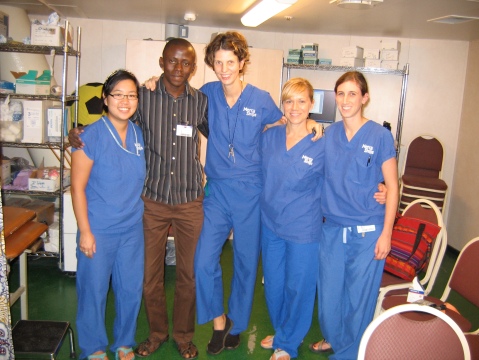
These are the members of the orthopedic team for most of the year. From left to right: Olivia Yeung (physical therapist), Arsene (our dedicated translator), Andrea (full time mom and part time physical therapist), Jana (physical therapist) and me!
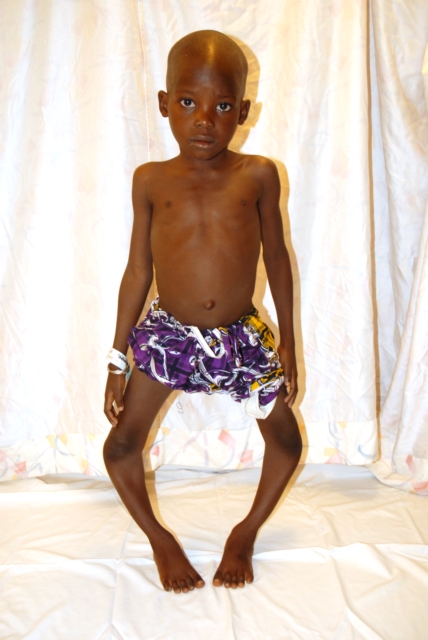
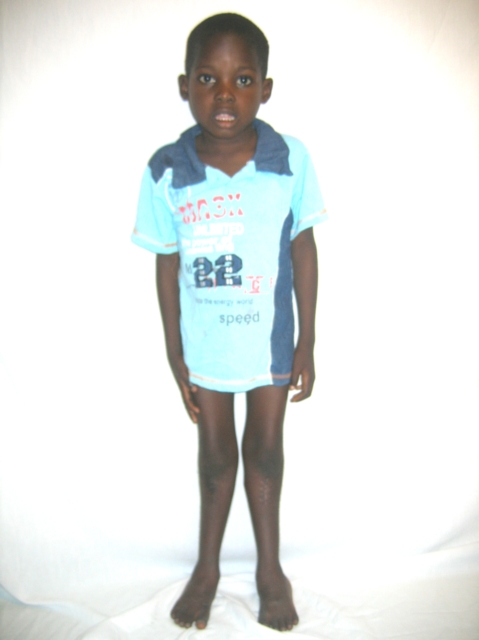
This is a common before and after picture of a kid with bowed legs. They are not happy when we’re taking the casts off, but are certainly happy that they have straight legs.
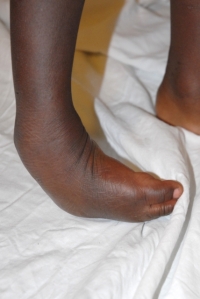
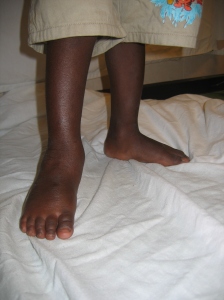
A before and after of a club foot that had surgery. They have to retrain their muscles to walk normally after surgery.
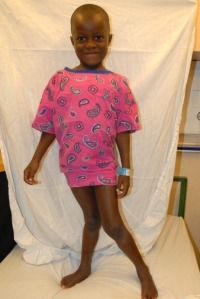

This little guy was obviously happy all the time, especially after he had surgery to correct his knock knees


This patient told me his story as I was discharging him from the clinic. He had been in a motorcycle accident 2 years before and had broken his humerus. He had spent over $1000 dollars trying to fix the arm, and the doctors finally told him there was nothing they could do, and the arm would have to be amputated. The day they told him that was the day that he heard about Mercy Ships, and we were able to see him and fix his arm for free. He was so thankful. The wounds you see on his arm are from another recent motorcyle accident- a pretty common occurance in Benin.
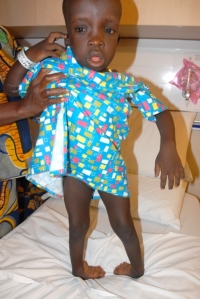
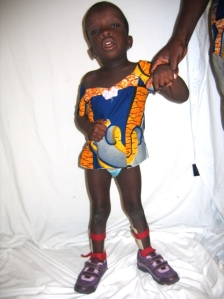
Victoire had some neurologic problems, and had never walked before. All she needed was a simple procedure to lengthen her Achilles tendon for her feet to be flat, but we weren’t sure if she would be able to walk because of her neurologic problems. But she came back walking on her casts- her dad was so happy. The PT’s made her some braces after her casts came off, and she was walking without much help from us!

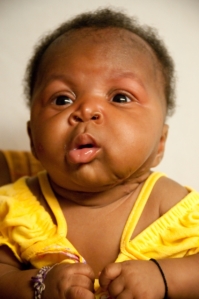
Maomi was born with a small tumor on her face that became larger and larges during her first few months of life. I was able to admit her for surgery to have the tumor removed, and at the time she only weighed about 6 pounds because the tumor was taking so much of her nutrients. It was a difficult surgery and post-op time, but she eventually started gaining weight and is a healthy little girl now.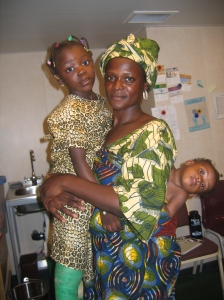 A common scene in the orthopedic clinic- a kid with casts on both legs carried on the front, and a curious toddler wrapped on the back.
A common scene in the orthopedic clinic- a kid with casts on both legs carried on the front, and a curious toddler wrapped on the back.
 This is one of my favorite club feet babies who happened to have a cleft lip as well. He came to us at about 5 weeks old and we put new casts on him every week for about 7 weeks to fix his feet. At the end of the casting he still needed a small procedure to finish the process. There were no more orthopedic surgeons on board at the time, but one of the local surgeons who had trained on the ship came and did his final procedure. While they were in surgery the surgeon decided to fix his lip at the same time, so there was much rejoicing from the family to now have a child that could walk and talk normally as he grows up.
This is one of my favorite club feet babies who happened to have a cleft lip as well. He came to us at about 5 weeks old and we put new casts on him every week for about 7 weeks to fix his feet. At the end of the casting he still needed a small procedure to finish the process. There were no more orthopedic surgeons on board at the time, but one of the local surgeons who had trained on the ship came and did his final procedure. While they were in surgery the surgeon decided to fix his lip at the same time, so there was much rejoicing from the family to now have a child that could walk and talk normally as he grows up.
I have many more pictures and stories that I would love to share with you if you want to hear more. I am currently in Dallas right now looking for jobs and asking the Lord if and when He wants me to go back and serve in Africa. Thanks for all of your support, I truly appreciated it!
If the shoe fits, wear it. If it doesn’t just make something out of plaster, string, and duct tape.
September 4, 2009
Things have been getting a little more creative in the orthopedic clinic now that we’re nearing the end of the orthopedic patients. For the most part we have had plenty of the supplies that we need, but the past month we haven’t had a physical therapist, and we have run out of these post-operative braces for club feet called Dennis Brown Bars. So me and the occupational therapist have been doing our best to give our patients physical therapy (it was interesting!) and I’ve been devising a way to make these bars that we need…
All kids that have been treated for club feet need to wear bracing until they are about 3 or 4 years old, because the deformity will continue to cause the feet to grow inward. So it is important for the long term success of the casting technique and surgeries that we be able to provide these braces for them. We ran out of a particular size of brace and shoe that goes with the brace about a month ago. Since then I have been on a search for someone in town to make these braces for me. I thought I had a good option with a man that makes prosthetic legs, but unfortunately I found out that the reason he had not brought me the braces was because he had become sick and passed away. So we gave our condolances and continued the search.
The only other prosthetic maker in town was at the university hospital, so my translator, Arsene and I headed to the hospital hoping to return with some braces and shoes. But after an hour of back and forth with promises that they could make the bars and shoes in under and hour, all for the low price of $20….it was discovered that no, we had to go find special shoes in the market, and they would then charge us twenty bucks to screw them in to a 5 cent piece of plastic. Hmm…no. Back to the drawing board. After a fruitless day of looking for shoes in the market, I decided to just go ahead and try to make the bars and shoes myself.
My poor unsuspecting patient was a little 2 year old who already doesn’t like the mean yovo’s such as myself, because we put him in torture devices such as casts. So we didn’t start off well, but eventually we got him to hold still long enough to mold some splinting material around his feet to make little foot holders. Then it was up to deck 7 to the workshop to cut some wood and attach the foot holders at the right degree of rotation. I f0und about 3 engineers who were more than willing to help me out with that. Then back down to the clinic, where we fastened the shoes on with velcro, and after a small crying spell, it seemed to fit him fairly well.
So here is the finished product. 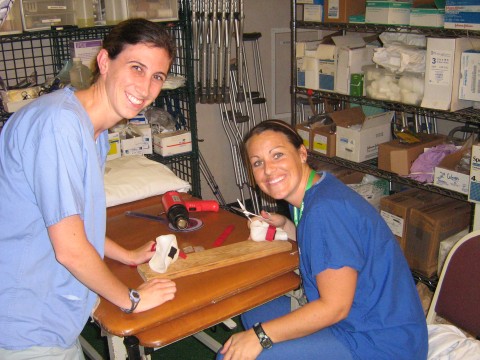
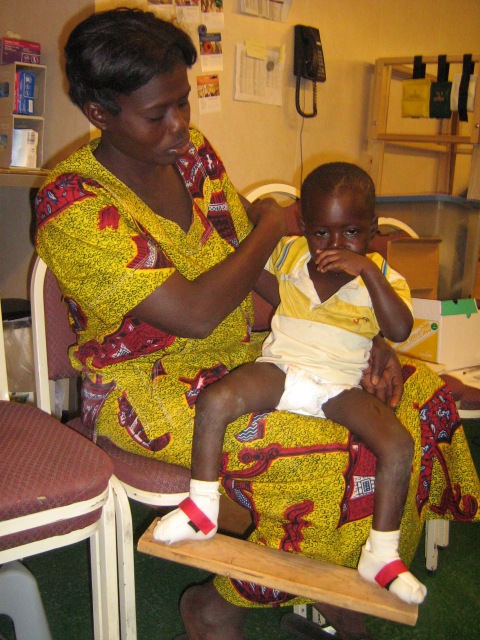
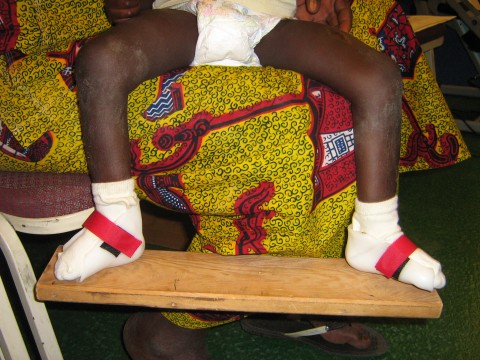
The only thing I can really say about it is it’s functional. I told my friend Jana, the PT who is also a bracing extraordinaire, about the new brace. She decided that a fitting slogan for a brace such as this was, “If the shoe fits, wear it. If it doesn’t, just make something out of plaster, string, and duct tape.” I don’t have plans for mass production yet, but we’ll see.
International dining
September 1, 2009
This weekend my friend Estelle wanted to make a milk tart, which is a South African dessert, to go with the fajita night that the Texans in the group were making. So she dutifully bought all of the ingredients to make this milk tart, and as we walked in to the crew galley I was greeted by the aroma of multiple meals being cooked. Everywhere we looked the counters were full of ingredients and dishes from all over the world. The smells were almost too much for my nose, and I’m quite sure all of the spices were too much for my wimpy taste buds. But nevertheless I looked around amazed at the variety of food being cooked that reminded people of home.
Where else but on a ship with over 40 countries represented would you get food from so many places? I mean, we had food from Sri Lanka, Nepal, Ghana, Liberia, England, Wales, South Africa, and last but not least, Texas. After clearing a small space we ended up finishing the milk tart (which was excellent by the way) and had a feast with homemade tortillas, guacamole, and beef fajitas. I also tasted just enough of the curry to burn most of my tastebuds off before we started the meal, but it was worth it!
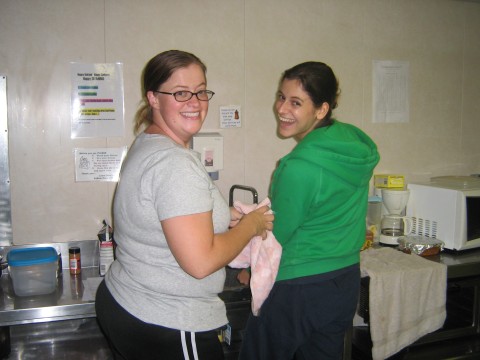
Allison and Estelle working on the milk tart
Will donate blood for Dr Pepper
August 20, 2009
It all started with an offhanded remark I made to my friend Sarah, who happens to be the lab tech/blood bank person, about the Dr Pepper I saw in the lab. We occasionally get Dr Peppers from the states, but we’ve recently had a dry spell of Dr Peppers and I haven’t had one in quite some time. So I mentioned that I saw one in the lab, and she said, “Well, if we need your blood, then you can have it.”
Here on the ship we don’t actually have a blood bank, as there is no place for the blood to be stored, so the crew is our “walking blood bank” so to speak. Occasionally you’ll hear someone’s name being announced over the intercom being asked to report to the lab and you know someone needs blood. I signed up a while ago to be a donor, but I haven’t actually been cleared to give blood until recently. I didn’t think much about my Dr Pepper comment until Sarah came up to me and said, “So how about that Dr Pepper?” And I said of course I would give blood, especially if there was a Dr Pepper involved. So a large needle and 500 mL of blood later, I had my blood and Dr Pepper in hand.
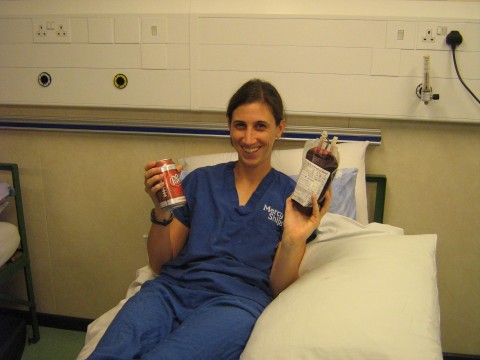 If I stop and think about it, I live in such an unusual environment. I mean, my walk to work is shorter than my walk to get breakfast, and at any time I could be asked to give blood for the patients that we’re operating on. It’s crazy, but I love it. Especially when it means I get help someone AND enjoy a Dr Pepper at the same time.
If I stop and think about it, I live in such an unusual environment. I mean, my walk to work is shorter than my walk to get breakfast, and at any time I could be asked to give blood for the patients that we’re operating on. It’s crazy, but I love it. Especially when it means I get help someone AND enjoy a Dr Pepper at the same time.



